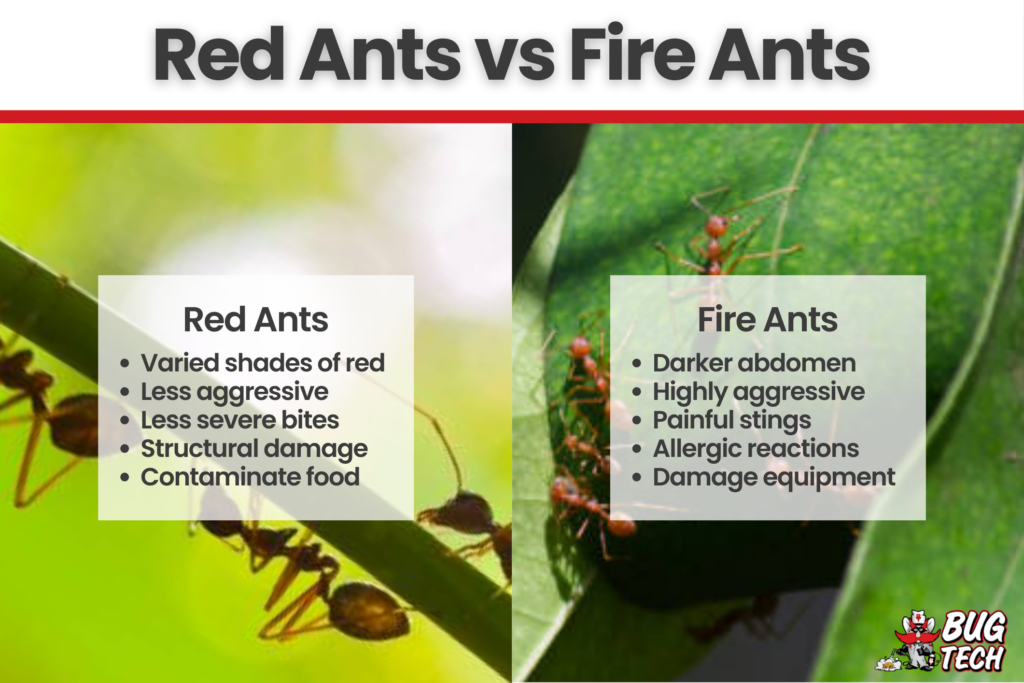Red Ants vs. Fire Ants: Understanding Their Differences and Impact
Ants can turn a peaceful garden or a bustling business into a battleground of pests. Their presence is often shown by dirt mounds in gardens or yards, which can indicate different ant species. Among these, “red ants” and “fire ants” are terms frequently used but can be confusing due to their overlapping characteristics. This blog will provide an in-depth exploration of these ants, focusing on their differences, impacts, and effective pest control measures.

The Many Faces of Red Ants
The term “red ants” covers a broad range of ant species with reddish or reddish-brown coloration. Understanding these species is crucial as each type of red ant has distinct characteristics and impacts on the environment.
Acrobat Ants
Acrobat ants are named for their unique behavior of lifting their abdomen over their head and thorax when disturbed. These ants are commonly found in sunny areas and woodlands. They typically build their colonies in tree canopies, using their agility to navigate and establish nests. Although they can be a nuisance, acrobat ants are generally less aggressive than other ant species and are not known for causing severe damage.
Argentine Ants
Argentine ants, originally from South America, have spread globally, including in Lubbock, Texas. These ants are notorious for forming supercolonies, which can span extensive geographic areas. Their ability to create large colonies allows them to outcompete native ant species, displacing them and disrupting local ecosystems. Their presence in urban areas can be problematic, as they invade homes and food storage areas.
Carpenter Ants
Carpenter ants are known for their nesting habits in wood, which they excavate to create their colonies. Unlike some other red ants, carpenter ants do not consume the wood but cause significant structural damage by weakening wooden structures over time. This is especially concerning in urban areas where wooden buildings are common. Carpenter ants can cause costly repairs if their nests are not managed properly. Their painful bites, though not as severe as fire ant stings, can cause irritation and swelling.
Fire Ants: A Deeper Look
Fire ants are a specific group within the genus Solenopsis and are particularly notorious for their aggressive behavior and painful stings. The most well-known fire ant species is the Red Imported Fire Ant (Solenopsis invicta Buren), which is native to South America but has become a significant invasive species in the United States.
Red Imported Fire Ant (Solenopsis invicta)
The Red Imported Fire Ant is known for its painful stings, which produce a burning sensation and can lead to pustules. The venom of Solenopsis invicta contains alkaloids and formic acid, which cause intense pain and irritation. This venom can result in severe allergic reactions in sensitive individuals. The fire ant sting is particularly dangerous because it can lead to anaphylaxis, a life-threatening condition that requires immediate medical attention.
Solenopsis richteri
Another species within the Solenopsis genus, Solenopsis richteri, is often found alongside S. invicta. It shares many characteristics with the Red Imported Fire Ant, including aggressive behavior and painful stings. Both species contribute to the fire ant problem in the United States, particularly in the Southern United States.
Fire ants are also known for their large, visible mounds, which serve as the entrance to their nests. These mounds can be a significant nuisance in lawns and public spaces, disrupting outdoor activities and posing risks to pets and people.
Ant Infestation Challenges
Ant infestations can cause various issues, from painful stings and bites to structural damage and contamination of food supplies. Understanding these impacts can help in choosing effective pest control solutions.
Painful Stings and Bites
- Fire Ant Stings: The sting of a fire ant is infamous for its intensity. It causes a burning sensation and can result in painful pustules. The venom contains alkaloids and formic acid, which contribute to the severe reaction. Individuals who are sensitive to this venom may experience severe allergic reactions, including anaphylaxis.
- Red Ant Bites: While many red ants can bite, the severity of the bite varies by species. Carpenter ants, for example, may deliver a painful bite that causes irritation and swelling but is generally less severe compared to fire ant stings. Unlike fire ants, carpenter ants do not sting, but their bites can still be painful and cause minor injuries.
Structural Damage
- Carpenter Ants: Carpenter ants are particularly problematic due to their nesting habits in wood. They excavate wood to build their nests, leading to significant structural damage over time. This is a major concern for property owners, especially in areas with wooden structures. The damage caused by carpenter ants can be extensive and costly to repair if not addressed promptly.
- Fire Ants: Although fire ants do not typically damage wood, their nesting behavior poses other risks. They are known to infest electrical boxes and equipment, leading to short circuits, power outages, and potential fire hazards. Their presence in electrical equipment can be a serious concern for property owners and businesses, as it can lead to costly repairs and safety issues.
Food Contamination
Ants, including both red ants and fire ants, can contaminate food supplies. They are often attracted to food storage areas, leading to sanitation issues and potential health risks. Keeping food sealed and maintaining a clean environment is essential to preventing ant infestations. Both red ants and fire ants can compromise food safety and hygiene, making it important to manage their presence effectively.
General Disruption
Fire ants are particularly aggressive and can disrupt outdoor activities. Their large mounds are a nuisance in lawns and public spaces, making them a safety hazard for individuals and pets. Their aggressive behavior can also pose risks to those who come into contact with them. The presence of fire ants can make outdoor areas less enjoyable and potentially hazardous.
Long-Distance Migration and Invasive Species
Ants are known for their impressive migratory abilities, which contribute to their spread and impact. Both red ants and fire ants exhibit behaviors that allow them to migrate long distances and establish new colonies.
Fire Ant Migration
Fire ants, particularly Solenopsis invicta, are capable of long-distance migration. Newly-mated queens are crucial to this process, as they establish new colonies, lay eggs, and grow the population. This ability to rapidly colonize new areas contributes to their success as invasive pests. Fire ants can quickly spread across large areas, disrupting local ecosystems and outcompeting native species.
Red Ant Migration
Some red ant species, such as the tawny crazy ant, are also known for their long-distance migration. This behavior allows them to spread across extensive areas and potentially displace other ant species. The migration of red ants can have significant ecological impacts, affecting local wildlife and disrupting ecosystems.
Effective Pest Control Solutions
Managing ant infestations requires a comprehensive approach to minimize their impact on your property. Effective pest control involves several key steps:
1. Inspection and Assessment
The first step in managing an ant infestation is to identify the ant species and assess the extent of the problem. This helps in determining the most effective treatment plan. A thorough inspection can identify entry points, nesting sites, and areas of activity.
2. Customized Treatment
Once the infestation has been assessed, a customized treatment plan can be developed. This may include baiting, insecticide treatments, and habitat modification. The choice of treatment will depend on the specific ant species and the severity of the infestation.
3. Prevention
Preventive measures are essential to reduce the risk of future infestations. This involves sealing entry points, removing food sources, and maintaining a clean environment. Regular inspections and maintenance can help in keeping ants at bay and preventing new infestations.
4. Professional Assistance
For specialized pest control that addresses both common and challenging ant infestations, professional assistance may be required. Pest control experts can provide tailored solutions to effectively manage ant problems and ensure a pest-free environment.
Take Control: Expert Solutions for Ant Infestations
Understanding the differences between red ants and fire ants is crucial for effective pest management. While red ants include various species with distinct impacts, fire ants are particularly notorious for their painful stings and aggressive behavior. Their presence can lead to significant discomfort, structural damage, and food contamination.
For comprehensive pest control that effectively addresses both red ants and fire ants, Bug Tech offers expert solutions tailored to your needs. Our team is equipped to manage and prevent ant infestations, ensuring your property remains secure and comfortable. Contact Bug Tech today for professional pest control services and take control of your ant problems with confidence.
